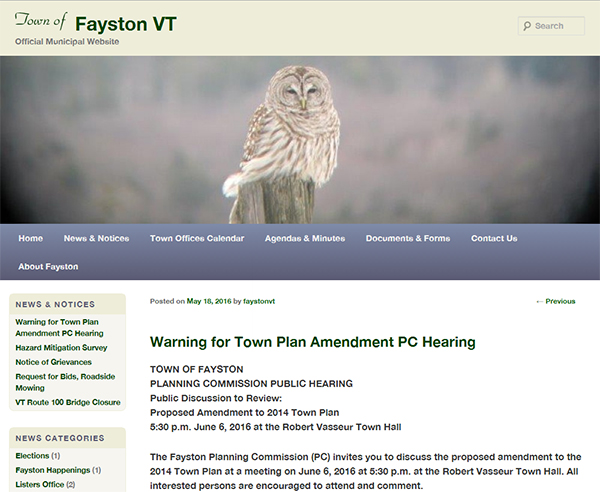Fayston has proactively protected its residents from unwanted energy facilities and antennas.
On July 18, the Fayston Select Board approved amendments to their Town Plan that had last been updated in 2014. The section that has been updated is Chapter 8: Community Facilities – Schools, Services and Energy and specifically it is the section titled Siting of Energy and Communication Facilities.
Energy siting has been controversial in Vermont for years and by amending their Town Plan, Fayston has taken a step toward protecting the town from unwanted state projects.
In January 2015, Vermont Telephone Company wanted to install a broadband tower on High Country Road. The Fayston Planning Commission addressed the select board at a meeting on January 12 and noted that in the Town Plan there can be no construction of telecommunication or energy facilities above 1,700 feet or in areas that affect the scenic value of the area.
The select board did not support the application for those reasons and Jared Cadwell prepared a letter for the Public Service Board.
Vermont Telephone Company did not go forward with constructing the broadband tower in Fayston, but it was noted at the same select board meeting that the Public Service Board does not have to defer to municipalities on the siting of such antennas.
Ed Read, a select board member, said that Fayston needed to put all of their concerns into the Town Plan to shield itself from further unwanted projects.
The amendments that were made were born out of the issue with Vermont Telephone Company, according to John Weir, Fayston’s zoning administrator.
The Vermont Public Service Board oversees all projects that relate to energy siting, but municipalities that have a comprehensive energy plan in their Town Plan will be given further deference with the Public Service Board in the future.
The Public Service Board is currently in the process of creating guidelines for towns on what a comprehensive energy plan entails. The guidelines are expected to come out in November.
Read hopes that the energy plan does not need to be amended again in the fall after the guidelines come out, but there is no way to know if the new energy plan will fit the state’s regulations.
The amendments made do not allow construction of energy and telecommunication facilities above 2,500 feet and include extensive regulations on energy siting to protect surface water, groundwater and mapped protection areas and core forest areas.
The amendments also protect against energy and telecommunication siting that would alter the scenic viewing areas in Fayston.







